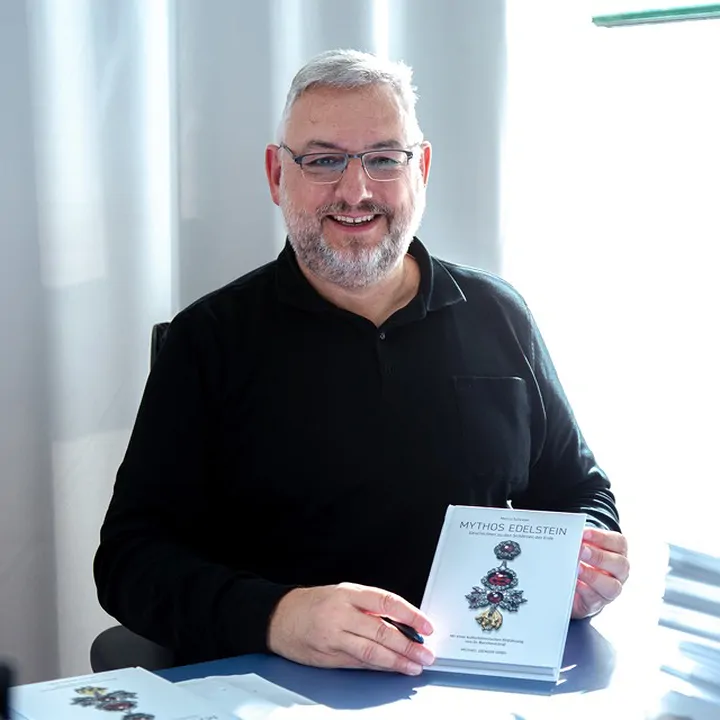
A warm welcome to you!
Since 1981, my mineral wholesale business in Ludwigsburg near Stuttgart has been your innovative and reliable partner for the gemstone, healing stone and jewelry trade worldwide, as well as for jewelers, goldsmiths, naturopaths, therapists, massage practices, yoga studios, Feng Shui consultants and other people who work with minerals and gemstones in their profession.
Minerals, fossils, rough stones and gemstones are used in a wide variety of ways: in jewelry, as valuable gifts, as stones in therapy, in massage and wellness and as room accessories, decorations and collector's items. Special unique pieces can also be valuable investment objects.
Divided into the four leading quality brands Chili Jewels®, Chili Creative®, Lapis Vitalis® and Maulwurf - Gifts from Nature®, you will find around 18,000 items in the online store.
Of course we are happy to advise you directly! Many of our colleagues speak English. Please contact us directly with your request:
+49 7141 4412 0
sales@marcoschreier.com
Have fun browsing and digging!
Good luck!
Your Marco Schreier

 Chili Jewels - designer jewelry
Chili Jewels - designer jewelry
Handmade unique silverjewelry as well as small and fine series of Silver jewelry with real stones can be found in this part of our assortment.
We make rings, Earstuds, pendants, bracelets and necklaces by hand and like to combine unusual stones with silver and gold-plated silver in our design studio in Ludwigsburg. Ideal for galleries, high-end gift stores, jewelers and goldsmiths who want to complement their product ranges. Our favorite stone is Larimar, but you will also find many other rarities such as Ammolite and rare opaque gemstones in unusual shapes and colors. The Chili Jewels range is complemented by high-quality silver chains and Omega necklaces.
Popular wholesale categories:

 Chili Creative - design your own jewelry
Chili Creative - design your own jewelry
Our Chili Creative range is ideal for goldsmiths, jewelers and artisans who like to design their own unique jewelry with real stones.
Here you will find everything you need for jewelry design, Bead stringing, wire wrapping, earrings, silver holders for drilled stones and donut holders. A huge selection of drilled gemstones, donuts, stone strands, beads and intermediate parts is available.
This is complemented by Clasps made from real silver, gold-plated silver and rhodiniert silver as well as all accessories such as design clasps and Lobster Clasps made from sterling silver and high-quality, tried-and-tested tools.
Top themes for creative freelancers:

 Lapis Vitalis - wellness with precious stones
Lapis Vitalis - wellness with precious stones
Gemstone wellness, gemstone massages, hot stone, reflexology and many other alternative treatment methods use minerals and gemstones as therapy stones.
You will findextensive literature, such as the book Heilsteine von A bis Z by Michael Gienger, CDs & DVDs and information material (posters etc.) as well as all important types and forms of therapy stones in our range. Our range also includes massage stylus, Flat Stones, Chakra Stones and Hot Stone Sets as well as VitaJuwel products, Gemstone Balance® articles and Water Stones. Ideal for therapists, masseurs, wellness studios and therapy stone consultants and advisors.
Popular wellness topics for professional users:

 Mole - Gifts from Nature
Mole - Gifts from Nature
Gifts and collector's items made from genuine gemstones, minerals, fossils and precious stones.
As a reseller, you will find everything your customers desire here: from Tumbled Stone as a hand flatterer to inexpensive stone jewelry, necklaces and pendants, stone hearts, rough stones, fossils and minerals for small and large collectors to sales aids and vending machines and displays with lucky stones, astro stones, power bracelets and much more. In the Gallery of the Earth ® section you will find great unique pieces, showpieces, earth keepers and particularly valuable unique items.
We are particularly fond of museum stores, show mines, adventure worlds, theme parks, zoos and other facilities for experiencing nature. Here you will find Europe's largest range of souvenirs and gifts made of precious stones for young and old.
The best for resellers and museum stores:



























